Main courses
Eastern Mediterranean influences:-
Roast vegetables with couscous
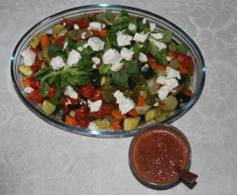
This was originally a DELIA SMITH RECIPE complete with spicy hot sauce. The original dish was dressed with salad leaves and goats cheese. You can also mix the vegetables with the couscous.
You can use: cherry tomatoes, peppers, onions, garlic, courgettes, aubergines, bulb fennel and most other seasonal vegetables. I calculate a typical selection at around 800kcal. Making the whole couscous dish with the feta cheese and a little sauce around 250kcal per serving.
JON’S HOT SAUCE
100 ml. of extra virgin olive oil. (825kcal)
2 tablespoons ground cumin – or to taste.
2 tablespoons tomato puree (about the same volume as cumin). (75kcal.approx.) (depending on concentration)
Juice of 1 or 2 lemons or limes. (15kcal)
Cayenne pepper or ground chili – to your taste.
A little salt if necessary. (915kcal. total)
Mix everything, add the chilli or cayenne and salt if necessary. Refrigerate for about 1 hour.
Correct the mixture to your taste; you should add a little water if the sauce is too thick.
FOR THE COUSCOUS
275g medium couscous (1000kcal)
500 ml hot Vegetable stock (15kcal)
A selection of Mediterranean vegetables.
Goat or Feta cheese a few salad leaves.
METHOD
Mix the sauce ingredients and refrigerate for at least 1 hour. Correct the mixture to your taste; you should add a little water if the sauce is too thick.
Place the couscous into a large heatproof bowl and pour the boiling stock over it and stir in with a fork. Cover with a cloth or cling film for 10 to 20 minutes by which time the stock will be absorbed and the couscous softened. Fluff-up the couscous and check the seasoning.
Prepare the vegetables by cutting them into small pieces, dry them and toss in a little olive oil and seasoning, then roast on a shallow tray at 200 °C until they just start to become a little brown.
When the vegetables are cooked and cooled, arrange on the couscous. Garnish with lettuce leaves and feta cheese (200g = 525kcak) and drizzle some of the sauce over. Present the rest of the sauce in a bowl beside.
Home made pasta:
Why make your own pasta when you can open a packet of the dried stuff? Well its all down to the taste. Making a batch of pasta dough takes about 20 minutes. We make a batch and freeze half for another day – freezing improves it. Take it out of the freezer in good time and if you have a pasta roller, simple spaghetti or tagliatelle can be ready to cook while the water comes to the boil.
THE QUESTION OF FLOUR? Use a semolina or durum wheat like the Italians. We find most other flours can make the cooked pasta slimy!
INGREDIENTS: (For 4 portions)
220g to 250g flour (see notes)
2 medium eggs
5g fine salt
Olive oil (just a little)
A splash of water.
Flavours etc. (if desired)
METHOD
Mix the Flour, eggs salt and oil in a bowl and add a little cold water to make the dough workable. (At this stage you could add some puree of tomato or spinach to both colour and flavour the pasta. I often add some turmeric powder to give the dough a yellowish colour.)
Turn the dough onto a work surface, knead well, adding more flour as required. Wrap in cling-film and refrigerate for at least 1 hour. Bring it back to room temperature before rolling it out.
RISOTTO (with shrimp or smoked salmon)
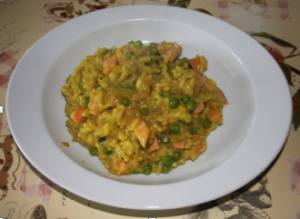
You can use the basic recipe on its own or add something different (mushrooms for example).
I often just use two or three ‘Boursin’ garlic and herb cheese cubs stirred in at the end with a little extra water.
INGREDIENTS: (2 to 3 servings)
1 tbsp. Olive oil (90kcal)
100g Leek chopped finely (60kcal)
100g celery chopped finely (15kcal)
150g Risotto rice (Arborio) (195kcal)
750 ml vegetable stock (15kcal)
1 glass white wine (100-125ml) (125kcal)
A handful of frozen peas. (55kcal)
Salt if required and freshly ground black pepper. (You can use a tsp. or cube of soft cheese and herbs as seasoning). Fresh herbs basil etc. to your taste.
Shrimps or smoked salmon pieces. (175kcal)
1 tbsp. low fat cream or yoghurt (15kcal)
(745kcal total about 370 per serving)
METHOD
Gently fry the leek and celery in a large pan for 3 minutes. Add the rice and gently fry for another 2 minutes. Meanwhile prepare the hot stock and place near the pan. Add the wine to the hot pan and stir continuously. As the liquid in the pan is absorbed by the rice, add some of the hot stock ladle by ladle until the rice has absorbed all the stock and is creamy and tender. This will take about 20 minutes. Add a little more hot water if necessary. You can also add a handful of frozen peas to the rice during the latter stages of cooking.
Finish with the soft cheese, cream and add the shrimps or smoked salmon and some fresh herbs (basil) adjust the seasoning. With the fish you may like to add some lemon juice. I add some low fat crème fresh which also add a little sharpness. Serves 2 as a main meal.
QUICK CHICKEN
Yes this really is fast food:- you can serve it with rice or just some fresh vegetables, carrots, broccoli etc.
By the time the vegetables are ready so is the chicken!
I often use the ‘Boursin’ cheese cubes instead of cream.
INGREDIENTS
300g chicken breast cut into strips (490kcal)
1 tbsp. flour (120kcal)
Salt and freshly ground black pepper
A pinch of herbs of province (or fresh herbs
Curry powder (optional)
1 glass of white wine (100 to 125 ml) (120kcal)
A handful of frozen peas (50kcal)
2 tbsp. low fat cream (4%) or 0% fat yogurt (15kcal)
Olive oil for frying (90kcal)
METHOD
Mix the Salt pepper, dried herbs and curry powder in a bowl with the flour and coat the chicken pieces well. Fry the chicken in a little olive oil until just browning on both sides. Pour in the wine to deglaze the pan stir in the peas. Add any fresh herbs i.e. tarragon, parsley or coriander and let it rest for a few minutes. Finish with cream. 450 kcal per portion.
Omi Gisela’s BÖREC.
This classic Turkish dish traditionally consists of savoury fillings wrapped in a triangular parcel of filo pastry.
My mother-in-law always made version of this for parties and family gatherings.
She used to make a large pie it being less work than making vast quantities of the little pastries.
Because she never used a written recipe, over the years, I have developed my versions based on her instructions.
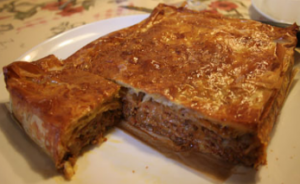
INGREDIENTS FOR THE MEAT VERSION
350 g of minced meet (beef, lamb pork or even a mixture (940kcal)
2 chopped onions (about 100 g) (42kcal)
1 tin 400 g of chopped tomatoes (or fresh tomatoes but take off the skins.) (96kcal)
2 large cloves of garlic (8kcal)
A large bunch of parsley (or dried) (50kcal)
2 tsps. curry powder Olive oil (150kcal)
1 stick of cinnamon (or ground cinnamon)
A packed of filo pastry 250 g (pastry sold as “brick” is not the same) (725kcal)
1 beaten egg (65kcal)
Salt and pepper to taste.
Total calories = 2076kcal 6/8 portions =345/260kcal
METHOD FOR THE MEAT VERSION
Fry the onion in a little oil, add the beef and brown. Add the garlic, curry powder and tomatoes. Add the parsley and season with salt and pepper to taste. Simmer for about 30 minutes and allow to cool a little.
Beat the egg in a small bowl and put some oil in another. Lay out the filo pastry (cover with a slightly damp cloth to stop it drying out).
Oil a (20cm x 30cm) baking dish and start laying individual leaves of filo in the dish with about 1/3rd is outside the dish. Build up enough layers to form a strong base brushing with beaten egg and oil to seal the leaves together. Add a thin layer of meet sauce and continue to build up more layers of filo and sauce until used. Use about 4 pieces of filo between each layer of filling bushing each leaf with a little oil.
Fold the overlapping leaves of filo over the pie using the egg and oil to seal the filo together. Brush top with egg and bake in oven 180C for 35 minutes.
A NON MEAT OPTION
It is possible to make a spinach and cheese version also derived from the traditional recipes but it can be very heavy in a large pie.
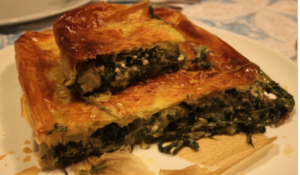
Placing the pie in the refrigerator for about 2 hours before baking it helps to make the pastry crisper.
Some shops sell a pastry called “brick” this is thicker and is often used for samosas but it’s not suitable for this dish.
You can serve the Börek from the baking dish but try to put some strips of greaseproof or baking paper in the dish then before building up the file. You should then be able to lift it out whole.
INGREDIENTS FOR THE VEGETARIAN VERSION
500g frozen spinach (or fresh if you like) (155kcal)
2 onions (around 100 g) (42kcal)
2 large cloves of garlic (8kcal)
Grated nutmeg
200g Feta cheese (540kcal)
Salt and pepper to taste
A packed of filo pastry 250 g 725kcal)
1 beaten egg (65kcal)
Olive oil (150kcal)
Total calories = 1685kcal 6/8 portions =280/210kcal
Both versions eat just as well cold or hot.
METHOD FOR THE VEGETARIAN VERSION
Fry the onion and garlic, add the spinach and if frozen let it gently thaw out in the warm pan before adding the grated nutmeg and season. Crumble in the feta cheese and proceed to build up the pie as in the meat version. Add a little milk or water if the mixture in too dry.
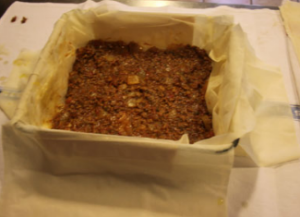
You can create a “hybrid version” with layers of the spinach and cheese mixture alternating with the meat.
I have also mixed some spinach with the meat sauce and it worked well.
Yorgia’s Moussaka Recipe
I have been making a version of Moussaka for about 30 years and had forgotten about it in recent times probably because we had become more health Conscious and it’s really not diet food.
My taste buds were awakened when I saw it being made by a Greek woman on Rick Stein’s television programme. He has given credit to this lady so I give my thanks to both of them.
This makes a large moussaka – Yorgia reminded me of my mother-in-law never working from a recipe, no quantities given but if you make too much it’s good the next day or it will freeze well.
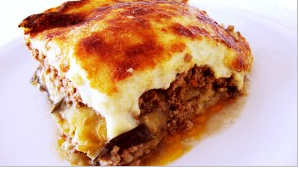
(It’s too depressing to calculate the calories of all these ingredients but my App. suggests that an American cup of (225g cooked creamy potatoes) is 300kcal plus! —- good luck)
INGREDIENTS
Olive oil
A couple of aubergines, or 3 or 4 courgettes (or a mixture of both).
Several good-sized potatoes
A large onion
Plenty of garlic (2 cloves minimum, you could go as high as 4)
A teaspoon or so of ground cinnamon, cloves and cumin
A little dried oregano
500g minced lamb or beef
A carton of passata or a tin of tomatoes.
For the bechamel:
Milk
About a soup-spoon of butter
About a table-spoon of plain flour
Well-flavoured cheese
2 eggs
Nutmeg, whole to grate (best for flavour) or ready-ground.
METHOD
1. Pre-heat the oven to 180C. Cut the aubergines or courgettes lengthways into slices about 1cm thick. Either lay them on oiled baking sheets – it doesn’t matter if they overlap – brush with olive oil, sprinkle with sea-salt and bake until soft and going slightly brown (20-30 minutes), or if you want to be authentic and you don’t care about the calories, deep fry the slices until golden and drain on kitchen paper.
2. Tackle your potatoes. Peel them, and either boil them until slightly underdone and then slice them (again, about 1cm thick), or slice them raw into rounds and deep-fry them too.
3. Prepare the meat sauce. Put a good splash of oil in a large frying pan over a medium heat and cook the chopped onion until soft. Add the garlic and spices and cook for another minute, then stir in the lamb or beef, cooking until brown. Add the tomatoes, oregano, half a teaspoon of sugar and a couple of bay-leaves if you have them, season well and simmer until the liquid is well reduced.
4. Meanwhile, make the bechamel. Melt the butter in a saucepan, add in the flour and cook briskly for a minute or two, stirring constantly. You’re looking for the consistency of thick cream; if you haven’t got that, add more flour or butter as appropriate. When this mixture is nicely blended, start to add milk a little at a time, heating after each addition and beating strongly to ensure the sauce is smooth. When your sauce is thickened to the consistency of yogurt, season and remove from the heat and allow it to cool.
5. Arrange a third of the aubergines / courgettes in the base of a large oven-proof dish, and add layers of potatoes and meat sauce. Repeat until you’ve used all you have to hand. Mix the eggs into the bechamel until well blended and pour the sauce over the vegetables and meat. Grate over a generous amount of nutmeg, and sprinkle with cheese. Bake for about 45 minutes until well browned, and then leave to cool for half an hour before serving.